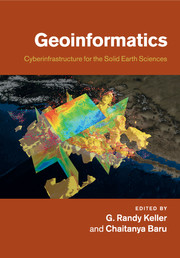Book contents
- Frontmatter
- Contents
- List of contributors
- Preface
- Introduction
- Part I Case studies from other disciplines
- Part II Modeling software and community codes
- Part III Visualization and data representation
- Part IV Knowledge management and data integration
- Part V Web services and scientific workflows
- 12 Service orientation in the design of a community hydrologic information system
- 13 Web services for seismic data archives
- 14 Development of robust data system for gravity and magnetic anomaly data: A case study of a community-based effort for point data
- 15 Scientific workflows for the geosciences: An emerging approach to building integrated data analysis systems
- 16 Online access and processing of LiDAR topography data
- 17 Use of abstraction to support geoscientists' understanding and production of scientific artifacts
- Part VI Emerging international and other efforts
- Index
- Plate section
- References
15 - Scientific workflows for the geosciences: An emerging approach to building integrated data analysis systems
from Part V - Web services and scientific workflows
Published online by Cambridge University Press: 25 October 2011
- Frontmatter
- Contents
- List of contributors
- Preface
- Introduction
- Part I Case studies from other disciplines
- Part II Modeling software and community codes
- Part III Visualization and data representation
- Part IV Knowledge management and data integration
- Part V Web services and scientific workflows
- 12 Service orientation in the design of a community hydrologic information system
- 13 Web services for seismic data archives
- 14 Development of robust data system for gravity and magnetic anomaly data: A case study of a community-based effort for point data
- 15 Scientific workflows for the geosciences: An emerging approach to building integrated data analysis systems
- 16 Online access and processing of LiDAR topography data
- 17 Use of abstraction to support geoscientists' understanding and production of scientific artifacts
- Part VI Emerging international and other efforts
- Index
- Plate section
- References
Summary
Scientific method and the influence of technology
Due to the increasing number and sophistication of data acquisition technologies, the amount of raw data acquired has vastly increased over the last couple of decades (Berman, 2008). This explosion of scientific data, growth in scientific knowledge, and the increase in the number of studies that require access to knowledge from multiple scientific disciplines amplify the complexity of scientific problems. In order to answer these “grand challenge” scientific questions, scientists use computational methods that are evolving almost daily. The basic scientific method, however, remains the same for the individual scientist. Scientists still start with a set of questions, then observe phenomena, gather data, develop hypotheses, perform tests, negate or modify hypotheses, reiterate the process with various data, and finally come up with a new set of questions, theories, or laws (http://en.wikipedia.org/wiki/Scientific_method). A recent change in this scientific method is that it is continuously being transformed with the advances in computer science and technology. The simplest examples of this transformation are use of personal computers to record scientific activity and the way scientists publish and search for publications online. More advanced technologies within the scientific process include sensor-based observatories to collect data in real time, supercomputers to run simulations, domain-specific data archives that give access to heterogeneous data, and online interfaces to distribute computational experiments and monitor resources.
Information
- Type
- Chapter
- Information
- GeoinformaticsCyberinfrastructure for the Solid Earth Sciences, pp. 237 - 250Publisher: Cambridge University PressPrint publication year: 2011
References
Accessibility standard: Unknown
Why this information is here
This section outlines the accessibility features of this content - including support for screen readers, full keyboard navigation and high-contrast display options. This may not be relevant for you.Accessibility Information
- 2
- Cited by
